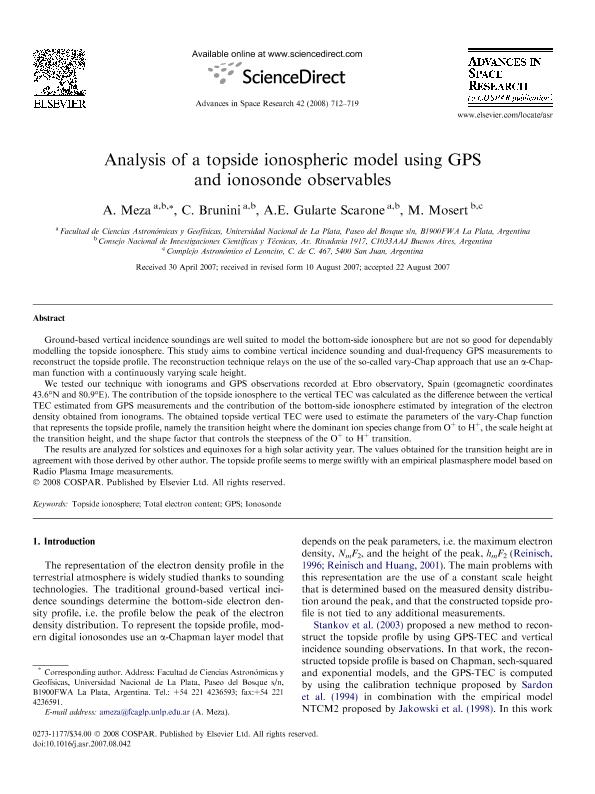Artículo
Analysis of a topside ionospheric model using GPS and ionosonde observables
Meza, Amalia Margarita ; Brunini, Claudio Antonio
; Brunini, Claudio Antonio ; Gularte Scarone, Angela Erika
; Gularte Scarone, Angela Erika ; Mosert, Marta Estela
; Mosert, Marta Estela
 ; Brunini, Claudio Antonio
; Brunini, Claudio Antonio ; Gularte Scarone, Angela Erika
; Gularte Scarone, Angela Erika ; Mosert, Marta Estela
; Mosert, Marta Estela
Fecha de publicación:
08/2008
Editorial:
Elsevier
Revista:
Advances in Space Research
ISSN:
0273-1177
Idioma:
Inglés
Tipo de recurso:
Artículo publicado
Clasificación temática:
Resumen
Ground-based vertical incidence soundings are well suited to model the bottom-side ionosphere but are not so good for dependably modelling the topside ionosphere. This study aims to combine vertical incidence sounding and dual-frequency GPS measurements to reconstruct the topside profile. The reconstruction technique relays on the use of the so-called vary-Chap approach that use an α-Chapman function with a continuously varying scale height. We tested our technique with ionograms and GPS observations recorded at Ebro observatory, Spain (geomagnetic coordinates 43.6°N and 80.9°E). The contribution of the topside ionosphere to the vertical TEC was calculated as the difference between the vertical TEC estimated from GPS measurements and the contribution of the bottom-side ionosphere estimated by integration of the electron density obtained from ionograms. The obtained topside vertical TEC were used to estimate the parameters of the vary-Chap function that represents the topside profile, namely the transition height where the dominant ion species change from O + to H + , the scale height at the transition height, and the shape factor that controls the steepness of the O + to H + transition. The results are analyzed for solstices and equinoxes for a high solar activity year. The values obtained for the transition height are in agreement with those derived by other author. The topside profile seems to merge swiftly with an empirical plasmasphere model based on Radio Plasma Image measurements.
Palabras clave:
GPS
,
IONOSONDE
,
TOPSIDE IONOSPHERE
,
TOTAL ELECTRON CONTENT
Archivos asociados
Licencia
Identificadores
Colecciones
Articulos(ICATE)
Articulos de INST.D/CS ASTRONOMICAS D/LA TIERRA Y DEL ESPACIO
Articulos de INST.D/CS ASTRONOMICAS D/LA TIERRA Y DEL ESPACIO
Citación
Meza, Amalia Margarita; Brunini, Claudio Antonio; Gularte Scarone, Angela Erika; Mosert, Marta Estela; Analysis of a topside ionospheric model using GPS and ionosonde observables; Elsevier; Advances in Space Research; 42; 4; 8-2008; 712-719
Compartir
Altmétricas



